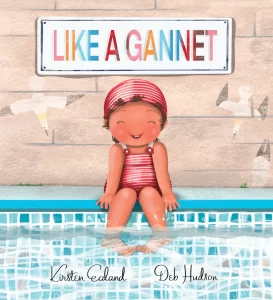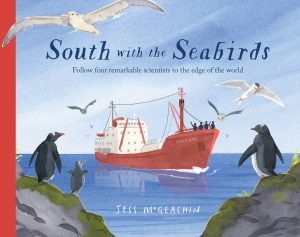



 Kirsten Ealand is a children’s book author from the Northern Rivers of New South Wales. Working part-time as a library assistant, Kirsten shares her love for books and reading with her community. It’s clear from her two picture books, Like a Gannet and The Big Backyard Plan, that they were written from the heart. Lauren Spencer sat down with Kirsten to discuss The Big Backyard Plan and other books that have impressed her.
Kirsten Ealand is a children’s book author from the Northern Rivers of New South Wales. Working part-time as a library assistant, Kirsten shares her love for books and reading with her community. It’s clear from her two picture books, Like a Gannet and The Big Backyard Plan, that they were written from the heart. Lauren Spencer sat down with Kirsten to discuss The Big Backyard Plan and other books that have impressed her. You mentioned that your first book, Like a Gannet, stemmed from a personal childhood experience. Are there any personal anecdotes in The Big Backyard Plan? I first had the idea when I was a kid. I lived in Sydney on the Northern Beaches. We had quite a big backyard, and I had a trampoline. I spent a lot of time jumping on the trampoline, and I remember clearly thinking, I see all the other backyards and hardly anyone is ever out in them. Everyone had the same sort of things that we had in our backyard, so it seemed wasteful that we all didn’t use our backyards very much, but we all had our own… trampoline or our own washing line, or whipper snippers. I remember thinking, why couldn’t we share all those things and have a bigger backyard? Ever since I had that idea, I have always wanted to write it into a book.
You mentioned that your first book, Like a Gannet, stemmed from a personal childhood experience. Are there any personal anecdotes in The Big Backyard Plan? I first had the idea when I was a kid. I lived in Sydney on the Northern Beaches. We had quite a big backyard, and I had a trampoline. I spent a lot of time jumping on the trampoline, and I remember clearly thinking, I see all the other backyards and hardly anyone is ever out in them. Everyone had the same sort of things that we had in our backyard, so it seemed wasteful that we all didn’t use our backyards very much, but we all had our own… trampoline or our own washing line, or whipper snippers. I remember thinking, why couldn’t we share all those things and have a bigger backyard? Ever since I had that idea, I have always wanted to write it into a book. Both Like a Gannet and The Big Backyard Plan reinforce empowering children and their voices. In this busy world of adult life, how do you tap into the voice of your inner child? I think I have quite a strong inner child. I still tap into that childhood, joyful, sort of feeling quite often. It’s quite easy for me to tap into that. I meditate, so that helps to quieten the mind. I just think I’m drawn to that, as I quite like kids, and I enjoy their company. When I do story time, I talk to the kids and connect with them. They are just really in the moment; they’re there, they’re excited about things, and I like that.
Both Like a Gannet and The Big Backyard Plan reinforce empowering children and their voices. In this busy world of adult life, how do you tap into the voice of your inner child? I think I have quite a strong inner child. I still tap into that childhood, joyful, sort of feeling quite often. It’s quite easy for me to tap into that. I meditate, so that helps to quieten the mind. I just think I’m drawn to that, as I quite like kids, and I enjoy their company. When I do story time, I talk to the kids and connect with them. They are just really in the moment; they’re there, they’re excited about things, and I like that. In your book The Big Backyard Plan, I found myself discovering tiny details on every page. How did you collaborate with Laura Stitzel on creating this world and how the story evolves? In my manuscript, I had an illustration note saying how I envisaged children of different ages in different family groupings. I tried to put that in the text that there were multiple generations living in one family, and different cultures, like Azumi being Japanese. My publisher got me to include a little character sketch of each child that they were going to show the illustrator. When Laura got it, she just ran with that idea. She put in the two-dad family and a single-mum family. I just love the way she tried to include lots of different people. That was important for the story. Laura went above and beyond what I could have hoped for; all the little details are just so beautiful. Laura tried to progress the story as she went through.
In your book The Big Backyard Plan, I found myself discovering tiny details on every page. How did you collaborate with Laura Stitzel on creating this world and how the story evolves? In my manuscript, I had an illustration note saying how I envisaged children of different ages in different family groupings. I tried to put that in the text that there were multiple generations living in one family, and different cultures, like Azumi being Japanese. My publisher got me to include a little character sketch of each child that they were going to show the illustrator. When Laura got it, she just ran with that idea. She put in the two-dad family and a single-mum family. I just love the way she tried to include lots of different people. That was important for the story. Laura went above and beyond what I could have hoped for; all the little details are just so beautiful. Laura tried to progress the story as she went through. You have spoken previously about being inspired by other authors in your writing. What books have you read recently that had a strong effect on you? Well, I love Hello Cocky by Hilary Bell. It’s such a good rhyme and nonfiction, which I love. I’ve been enjoying South with the Seabirds by Jess McGeachin. I really love this story and the way Jess writes historical and environmental stories. I also think Sakamoto’s Swim Club by Julie Abery is a beautiful book, which is also nonfiction. She writes in spare rhyme, and it makes this story so successful for kids because it says so much in so few words. I set myself a task to write in spare rhyme; I thought that would be a nice challenge. It’s hard but fun, and I love it. Getting the story down is my least favourite part. Playing with the language and finding ways to say it better is what I love most.
You have spoken previously about being inspired by other authors in your writing. What books have you read recently that had a strong effect on you? Well, I love Hello Cocky by Hilary Bell. It’s such a good rhyme and nonfiction, which I love. I’ve been enjoying South with the Seabirds by Jess McGeachin. I really love this story and the way Jess writes historical and environmental stories. I also think Sakamoto’s Swim Club by Julie Abery is a beautiful book, which is also nonfiction. She writes in spare rhyme, and it makes this story so successful for kids because it says so much in so few words. I set myself a task to write in spare rhyme; I thought that would be a nice challenge. It’s hard but fun, and I love it. Getting the story down is my least favourite part. Playing with the language and finding ways to say it better is what I love most.Error: Contact form not found.
